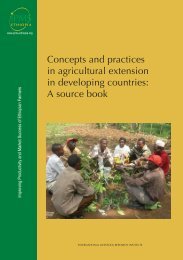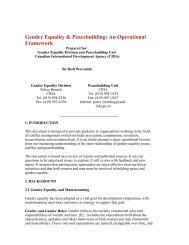CIDA's Policy on Poverty Reduction
Policy on Poverty Red.pdf - Ethiopia-Canada Cooperation Office ...
Policy on Poverty Red.pdf - Ethiopia-Canada Cooperation Office ...
- No tags were found...
Create successful ePaper yourself
Turn your PDF publications into a flip-book with our unique Google optimized e-Paper software.
A. INTRODUCTIONThe Government's foreign policy statement,Canada in the World, released <strong>on</strong> February 7,1995, provides a clear mandate for CanadianOfficial Development Assistance (ODA):"The purpose of Canada's ODA is to supportsustainable development in developingcountries, in order to reduce poverty and toc<strong>on</strong>tribute to a more secure, equitable andprosperous world."Canada's development assistance program recognizesthe vital link between poverty reducti<strong>on</strong> andsustainable development, and is built <strong>on</strong> a broadarray of programs and policies working togetherin an integrated way.<strong>Poverty</strong> results from the lack of human, physicaland financial capital needed to sustain livelihoods,and from inequities in access to, c<strong>on</strong>trolof, and benefits from political, social or ec<strong>on</strong>omicresources. In an interdependent world, povertyin developing countries increasingly affects theec<strong>on</strong>omic, social and political welfare of developedcountries. <strong>Poverty</strong> can lead to serious globalproblems, such as envir<strong>on</strong>mental degradati<strong>on</strong>,political and ec<strong>on</strong>omic instability, and large-scalemigrati<strong>on</strong> of people in search of a better life.In this c<strong>on</strong>text, the policy will provide a frameworkfor poverty reducti<strong>on</strong> and will guide programmingin each of the six programming prioritiesfor ODA: basic human needs; women indevelopment; infrastructure services; humanrights, democracy and good governance; privatesector development; and the envir<strong>on</strong>ment.In addressing the challenges posed by poverty,important distincti<strong>on</strong>s must be made between"relief" and "reducti<strong>on</strong>". <strong>Poverty</strong> relief addressesthe poor's survival needs, their immediate problems,and the effects of inequities. It does notenable the poor to secure or sustain their livelihoods,or to end the <strong>on</strong>going cycle of poverty.<strong>Poverty</strong> reducti<strong>on</strong> is a process by which the causesof deprivati<strong>on</strong> and inequity are addressed.Clearly, "relief" activities can be critical in dealingwith famines and other disasters-- indeed, shorttermsurvival strategies are crucial for theextremely poor. However, the challenge lies inmaking the transiti<strong>on</strong> from the short-termresp<strong>on</strong>se of relief activities to interventi<strong>on</strong>s whichwork to reduce poverty in the l<strong>on</strong>g run.<strong>Poverty</strong> reducti<strong>on</strong> is complex and difficult, anddespite c<strong>on</strong>siderable programming experience inCIDA, it remains a challenge. <str<strong>on</strong>g>CIDA's</str<strong>on</strong>g> approachto poverty reducti<strong>on</strong> will require:◆◆◆a better understanding of the country-specificand local characteristics of poverty;a coordinated use of project, program, instituti<strong>on</strong>alsupport and policy interventi<strong>on</strong>s toachieve maximum impact; anda clear view of <str<strong>on</strong>g>CIDA's</str<strong>on</strong>g> role and capabilities.2





